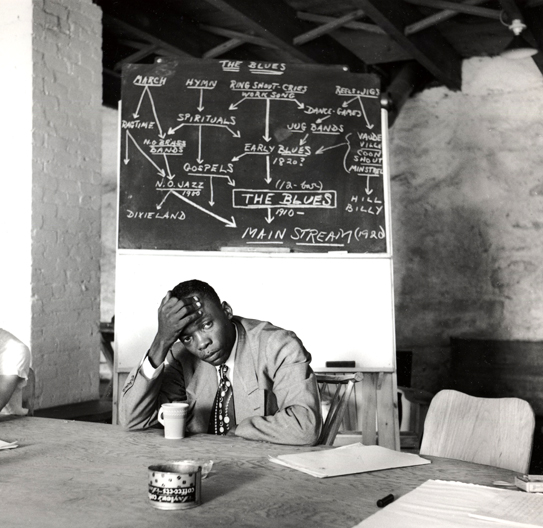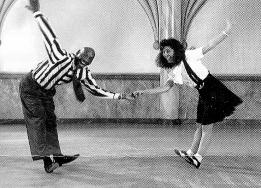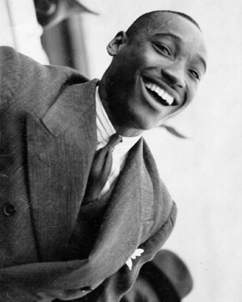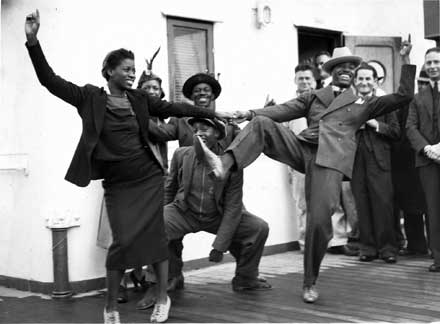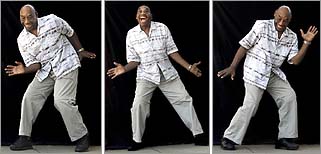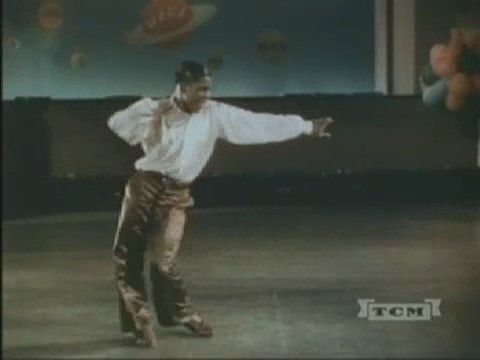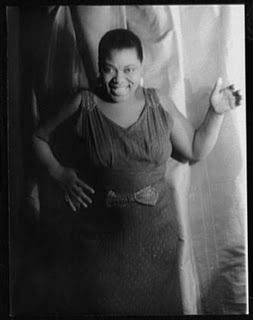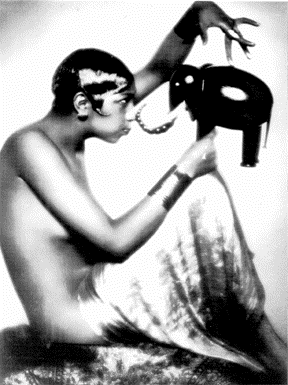
Once again, Bug’s Question of the Day has my brain working.
Recently there was a paper published in Research and Dance Education on “frame matching” where it is proposed that there is a “universal” methedology of lead/follow that can apply to all partner dances.
http://www.joeandnelle.com/assets/frame_matching_and_pted_by_joe_demers.pdf
However is it really Universal? I often hear complaints from blues dancers about “Lindy Connection”, and likewise from Lindy Hoppers about how “heavy” blues connection is.
Likewise, some say that the concepts of frame matching are different for different dances anyhow.
So, do the concepts of frame matching really apply universally to all partner dances?
Do these efforts help codify Lindy and Blues at least to the level of tango, or at least is a step in the right direction?
Or is it simply another step in the evolution of partner dancing in the swing/blues genres?
Wednesday 30th May
(full article reference: DeMers, Joseph Daniel, “Frame matching and APTD: a framework for teaching Swing and Blues dance partner connection,” Research in Dance Education (2012).)
I have lots and lots to say about this article. But I can’t fit them all into one post. Well, I could, but this post is already reeeeally long for a blog post. Only 2.5 thousand words, which is way short for a journal article (~5000 words). So I (may) return to this topic later, in other posts. Or not.
Sadly, DeMers’ article triggered my ‘marker’s brain’. Reading this, I’d assume the author was an undergraduate or in the early stages of a postgraduate degree (in the arts or humanities). But the author has a background in science, education and educational psychology, so I should be a little easier on him, as those fields don’t pursue such rigorous approaches to critical inquiry. But if you’re publishing a journal article, you really need to step up, yo. There are some problems with written expression which occasionally obscure the author’s point. There are problems with the construction of the argument as well as with the communication of this argument: it is too simple, and does not exhibit sufficiently rigorous critical engagement with the topic.
In other words, it is thinking in short, straight lines, rather than around corners and back and forth. My background is in cultural studies, which is all about thinking round corners. Further, I was into feminist cultural studies, which is about thinking around corners, asking difficult questions and refusing to shut up when some fuckwit tells you you “think too much.” So I’m sorry, DeMers, but this is going to be a fairly close criticism of your piece. But, before I get into it, I need to ask: “should I read scholarship from the dance world the way I read academic articles?”
I think there’s a clear cultural divide between the way arguments are constructed and communicated in the university world and in the dance world. In the latter, consensus, cooperation and empathy are valued far more than a ‘right’ answer. I think that this is – largely – a result of the influence of Frankie Manning, a man who was determinedly disassociated from local scene politics. His emphasis on the idea that ‘for three minutes you are in love with your partner’, on ‘bowing to the queen of the world’ and on humility make it clear that he felt dance (‘as the happiest thing on earth’) is about peace and fraternity, not conflict. I’ve found this approach frustrating when reading about his responses to racism in the American south in the 30s and 40s in particular (because I do think dance is a vehicle for radical political resistance as well), but I also deeply admire it as a truly pacifist response to cultural and physical violence. What better way to combat hate, than with love?
Writing this response, I was struck by a conflict in the two methods of discursive engagement I’ve used in the past. In the academic world, a forceful, even aggressive tone was important as a woman writing in a patriarchal, highly regulated and heirachical discourse. But in the dance world, where a harsh word or aggressive line has immediate real world consequences and runs in direct conflict with the ethos of international lindy hop ideology (ie Frankie would not have liked it). I’ve lately decided that one of the reasons I didn’t like academia very much was that it privileged aggressive, combative discourse. I feel that part of being a feminist is (to clumsily paraphrase Germaine Greer) to practice fraternity as a response to patriarchy.
So I’m going to try to do like Frankie did. But I’m also going to remember Norma Miller and her fury. Speak up, but be gentle. Mostly.
So let’s get to it. Let me engage with the article, point by point, with the fundamental premise of this article (this has gotten too long for just one post, so I’m just going to do one thing here).
The piece presents “frame matching” as a
codified theory of partner-dance connection (abstract, pg 1)
. Ok, yeah, that’s not such a problem. If you’re ok with the whole concept of ‘codified’ dance practice. In this context a ‘codified theory’ is a ‘set of theoretical rules or guidelines’. So this paper is establishing a set of rules for teaching and practicing partner dance, specifically in terms of connection (part of me wants to argue that there’s very little in partner dancing that isn’t about connection, whether you’re touching your partner or not). There are some useful aspects to this approach. As DeMers points out, adopting a code
…gives instructors a framework for creating a well-organized partner-dance curriculum, and gives them a means of assessing students’ working knowledge and execution of connection (pg 3)
This is such an appealing notion. Right now, as I’m trying to figure out exactly how I teach, and what I want to teach, the thought of a formal, fixed and reliable teaching tool kit is just so tempting. It’d be so much easier to just discover this foolproof, ‘right’ way of teaching the ‘right’ stuff. But this sort of approach also rings my alarm bells. I’ve done a heap of courses focussing on pedagogic practice in tertiary education over the years, and one of the most exciting ideas was that of the teacher as a guide to learning. Rather than adopting a ‘chalk and talk’ approach (where the teacher stands at the front of the room, dispensing knowledge), the student-centered class room sees the teacher (or tutor) as facilitating the student’s discovery of knowledge. Inherent to this approach is the idea that each student learns in different ways, and has different interests. By god that’s hard work. It’s really hard to work with thirty unique hoomans with thirty different ways of learning (all of which are changing constantly). Teaching would be SO MUCH EASIER if I could just pretend students were standardised units. And yet, that idea is also REALLY SCARY because it means that there’re also very wrong ways of teaching. PRESSURE!
Most usefully for me – as both a postgraduate learning to tutor and lecture and now as a dancer learning to teach dance – this student-centered model does not assume the teacher carries all the learnz around inside them. Rather, the teacher encourages and assists students in their discovery. For me, this means that I don’t have to be the cleverest person in the room, or the best dancer on the dance floor. I do have to be the person who manages the group, who guides the discussion of concepts and challenges (whether in verbal discursive exploration or in physical exploration), who encourages and supports new ideas and new ways of thinking. Granted, it’s fairly important for a teacher – in both a dance class and a university tutorial – to know a heap of things. But there will always come a point where the student reaches the edges of the teacher’s knowledge, ability, or experience.
For me, the most empowering thing I learnt about teaching was that it’s totally ok to say “I don’t know the answer to that. Why don’t we find out together?” It’s the same with dancing: I need to know some things, but it’s ok for me to reach a point at the limits of my physical ability or experience and then say “I don’t know why that works like that. Why don’t we find out together?” The delightful thing about dance is that it requires whole-bodied experimentation through play: lindy hop and swing music are all about having fun while learning stuff. One of the things I like most about lindy hop (and I extrapolate from DeMers’ work to assume that he feels his code can be used across the panopoly of jazz and swing era dances) is that it prioritises individual improvisation. Making stuff up. Breaking rules. But in a social way.
This is why I’m not entirely ok with the idea that we need a codified approach to dance practice or dance pedagogy. It presupposes a final, finite rule book for how we teach, how we learn, and how we dance. And that doesn’t sit well with me. I’d be heart broken to discover that everything there is to know about dance had already been written down. For me, the very best part of teaching has always been that moment when a student presents an idea that had never occurred to me (or anyone else), or moves their body in a way that is utterly unique. Suddenly I’m inspired and excited about teaching and learning. Hoomans are amazing: we are wonderful and surprising. I don’t want to forestall that with dancing rules.
In a practical sense, though, accepting that different teachers teach in different ways, and different students learn in different ways makes good financial and promotional sense. I work within a large dance scene with lots of teachers. I’ve realised that students don’t come to class and stay with that class just for the dance knowledge they’re developing. They come because they like that class’s culture (the people in the room, the way they interact, the physical space, the music, and so on and so on). In a market crowded with ‘dance experiences’, it makes sense to differentiate, to offer something unique. We are all teaching lindy hop (well, mostly… :D ), but we all teach in different ways.
The most powerful promotional tool we have at our disposal is the effective communication of that difference. Dancers’ best promotional tool is their own dancing body: we attract new students who see us dancing at public gigs; we attract existing dancers who want to learn ‘new’ things when they see us dancing in competitions or performances or on the social dance floor. But we also make extensive use of online, paper and face to face media and promotions. We have developed a language for selling our teaching, and this language is not politically or ideological neutral or ‘just descriptive’. The way we talk about dance and articulate what we feel in dance expresses the way we think about dance, and about our dance partners.
Arthur Murray’s pedagogic practices worked on a premise in direct opposition to this ‘diversity rocks’ idea. The assumption was/is that dance a) could be codified; and b) that it could be sold as a consistent, quality-controlled product in many different venues by many different people. It was a profoundly effective way of selling dance. But it was also a profoundly effective way of stifling individual creativity and the development of social dance practice as a living, breathing, changeable art.
I think about this approach as being the McDonalds approach to dance. Sure, you get the reassurance of consistent ‘food’, no matter where you are in the world, and the model ensures a high food safety standard. But that consistency has led to a preponderance of factory-farmed product where that quality is controlled by chemicals and cruel farming practices. The mundaneness of this consistency is countered with unnatural sensory experience: extra salt, extra sugar, extra fat, all efforts to replace the pleasures of a simple, authentic ‘flavour’ with artificial ‘taste’. Sometimes that’s how I feel about aerials: if your basic swingouts and footwork and rhythms are dull and pedestrian, you need air steps to make it interesting. This is why Skye Humphries and Todd Yannacone and Naomi Uyama and Ramona Staffeld and Frida Segerdahl and Lennart Westerlund are so amazing: they don’t need air to excite your palate (though they can certainly bring it if they need to).
I’m a big fan of the Montessori or free school learning and teaching model. I’d like to be able to encourage students to discover their own way of moving and expressing themselves, where they try to figure out what they love, and how they feel, and then work on expressing that with their bodies. There are physiological limits to what we can do with our bodies, but because all our bodies (and lifestyles) are unique, the bodies we work with are all unique. So the dancing we do, and the ideas that we have, are all unique. And that is what I think we should be working towards.
I have similar feelings about teaching dance. I recently organised a workshop weekend here in Sydney with some visiting teachers. We had one day of general workshops, and one day of ‘teacher training’. The teacher training was set up in two parts. One session where dancers worked on their own dancing specifically to improve their teaching (eg looking at how clearer lines or sharper footwork made it easier for students to see how the movement worked in demonstrations). The second session more a ‘skill share’ session where everyone shared their favourite teaching tools, asked specific questions about how other people taught particular things, and then experimented with these.
The presumption in this day of ‘teacher training’ was that the dancer/teachers involved were all skilled professionals with unique ways of working. The session was not to enforce a ‘preferred’ teaching code or to ‘improve the standard of teaching’, but to encourage reflexivity in teachers’ practices. To share ideas so that each teacher (and teaching partnership) could refine and develop their teaching practice in their own way. Inherent to this was the idea that teaching practice is mutable, flexible and responsive to the students’ needs, and to the teachers’ interests and needs. In other words, teaching different things in different ways to different people by different people. The end goal was of course unique pedagogic cultures and practices within the broader dance scene. Organic, gmo-free, visually unique, sensorily exciting.
I think the sessions went well, for a first-run. I had good feedback from participants (and I like to encourage all sorts of feedback), and from what I observed in the session, people enjoyed the experience. I do think that it takes time to learn how to participate in this sort of session, and that it takes a degree of trust: you need to trust your peers to support your ideas and not dismiss them. So I’d think that you’d really need to do this a few times to get the best results.
I have seen this approach used by other dance scenes and at other dance events. But my problem with some of those models is that though they ostensibly encourage individualised teaching practice and dance, they effectively maintain hierarchies and power. Most specifically, some of the people involved are established as ‘authorities’ and the collaborative setting is ultimately working to shore up the power of the organising person or ideologies. I’m certain this (inevitably, perhaps) happened in our setting this past weekend. But I’m hoping the organising ideology was ‘diversity and flexibility through collaboration’ not ‘uniformity and ‘correctness’ through collaboration.’
I do think that the best way to encourage a diverse, lalala learning environment is not to preach about it explicitly, but to sneak it into the process. So Herrang, for example, encourages dancers to interact in casual, friendly ways with old timers, with teachers, with each other not through formal ‘sessions for hiearchy-free interaction,’ but by setting up large communal eating areas where people share tables. I do think the shared table is an excellent metaphor for community, and it’s not just pragmatics that encourages many dance events to build meals into their programs.
Having said all that, part of me wants to know how can we do all this lovely hippy work and still be involved in a project of historical recreation and preservation? In a practical example, my teaching partner and I are currently figuring out exactly what type of swingout we want to teach to our class over the next month or so. We both have different preferences and ideas, but we’re both dance supernerds with an interest in biomechanics, a commitment to individual self expression, an emphasis on safety and pleasure, and we’re both guided by history. In a perfect world we’d work with the students to develop their awareness of their own bodies and and their basic skills so that they can choose how they dance their swingouts. In that same perfect world we’d introduce them to particular swingouts from lindy hop history, working with examples by particular dancers at different times. The ultimate goal would be to have each dancer being aware of what they’re doing in the swingout, and consciously choosing the way they move and respond to their partner. We both have particular favourites and dancers (both historic and contemporary) which we admire and want to emulate. But we also want our students to develop their own flavah flave.
The challenge, of course, is this: how do you actually run a class (or classes) which are historically grounded (and preserving/recreating lindy hop from the past) and also encouraging and allowing students to follow their own interests and personal creative instincts?
Interestingly, dance teachers like the Harlem/Rhythm Hot Shots are in an easier position: they are determinedly into historical preservation, and they position their classes and performances this way. They often say “This is our way of dancing a swing out, which we learnt from/modelled on Al Minns/Frankie Manning/Anne Johnson/Norma Miller, so we want you to learn to swingout this way.” The caveat is of course that once you’re done with the class you can just put aside that particular swingout and never do it again. But actually learning to dance precisely that way has taught you something about your body (and history) and more importantly, given you the ability to choose the swingout(s) you will do.
But my dilemma is this: how exactly do you do balance historical recreationism/preservation with student centeredness and principles of ‘natural’ movement and biomechanics in a weekly one-hour class that really has to be promoted in a clear, simple, accessible, totally-fun way, with a goal of maximum student numbers possible and mad dancing skillz? Week after week after week.
I guess the answer is that you don’t. Unless you really are a high-status, highly-skilled dancer like (my heroes) Asa Palm or Lennart Westerlund. In those cases what you are selling is historical accuracy, and students may choose to attend or not attend class. And as highly skilled, well respected dancers, students are likely to attend just because you’re teaching.
Or are they?
This is where we must balance pedagogic ideals with promotional and economic sustainability, individual creative self expression with historical preservation. To pull this stuff off, you just have to be one shit-hot teacher. Which is what the Hot Shots are: they are shit hot teachers and dancers.
Ok, so you can see, right here, that I’m going to have trouble with DeMers’ article. I can’t accept the basic premise of the thing: that there is a single codified theory for teaching connection, and that this is desirable, useful thing. I just don’t think that this is a useful approach: it doesn’t accommodate the complexity of hoomans in motion. But that doesn’t mean I’m not interested. I discovered the other day that Al Minns used a swingout that didn’t involve triple steps. This makes me freak out a little in my brain, but it also makes me intensely curious. HOW EVEN DID IT WORK? If I rely on triple steps to generate and maintain momentum and stuff syncopation into a swingout, if I rely on triple steps for covering more ground, how did Al Minns and his partners achieve all these things without triple steps?! I NEED TO KNOW. I MUST ACQUIRE ALL THE LEARNZ.
That’s how I feel about this article. The basic premise unsettles me, but it also invites my engagement.

